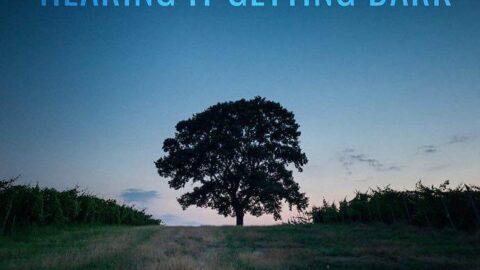Composer Reinaldo Moya’s debut album Hearing it Getting Dark (Furious Artisans) highlights the growth and maturation of a body of work exploring the intricacies of utilizing minimalist techniques intertwined with keenly intuitive lyrical narratives. Performances by Latitude 49, Francesca Anderegg, and Attacca Quartet portray a composer finding his voice as a storyteller; earlier compositions project experimentation with rhythmic structures placed over simpler forms, advancing to later pieces featuring compelling, character-driven shapes and progressions.
While Moya’s technical skills as a composer are consistently apparent, the album begins on unsettled ground. The album’s opening composition, Polythene–which Moya describes as a play “with the distinction between minimalism and sonata form”–lacks a clear direction, leaving Polythene to feel more like a film score with no plot. Even with Latitude 49’s precise and energetic performance of the work’s self-described “bewildering” form, the pairing of grooves and melodies seems timid as Moya searches for a more confident voice.

In Bonsai and Violin 3.0, Moya relinquishes his attachment to experimenting with preconceived structures by opting for simple material, moving through a more fluid and unfettered sense of time. Francesca Anderegg’s impeccable execution on Bonsai gives shape and nuance to the rapid arpeggiations that do not veer far from the early Baroque style. Moya’s image of material growing like a bonsai, firmly rooted but with small branches growing in all directions, is a strong source of inspiration, but does not manifest musically as the listening experience sounds more like a modified theme and variations with a few added elements. Moments of colorful and cohesive textures swirl, but are missing their full luster. A few too many ideas force material to a form that feels unnatural; one thoughtful concept, fully drawn out and explored, would have sufficed.
Moya is at his best when he has a clear storyline. Hearing it Get Dark, inspired by William Faulkner’s novel The Sound and The Fury, offers a clear programmatic structure for Moya’s visceral focus on lyricism and harmony. In this piece, Moya provides greater focus into the musical personification he seeks to portray; the composition is certainly the most engaging and well-crafted on the album.
The first movement, “Walking Shadow,” utilizes moderately unsettling lengths of atmospheric textures, unexpectedly interrupted by violent outbursts. With a clear emotive guide to mimic the progression of the work, Moya better hones his melodic and harmonic development in support of highlighting his characterizations. While the unpredictable shaping and construction of the movement engages and entertains, more nuance beyond the violent outburst would take it to the next level.

The development of Moya’s style as a composer evolves throughout Hearing it Get Dark. The other movements, “Clocks That Slay Time” and “She Smelled Like Trees,” feature Moya’s determination to represent the unpredictable moods by the book’s characters; the confidence shown in this stylistic direction offers the clearest and most thoughtful execution. Beyond the rich and dynamic performance, Attacca Quartet maximizes the music’s potential through an intimate understanding of the composers vision. Moya’s haunting melodic writing in “Clocks That Slay Time” are adeptly manipulated by fluctuating through Romantic harmonies and disintegrating into ethereal textures. While colorful, the full potential of textures rarely feels completely reached; harmonies are well-imagined and applied, but the spectrum of timbral instrumental colors is not fully utilized.
Hearing it Getting Dark is inviting if you enjoy a direct and light emotive narrative. Moya is deeply rooted in the Romantic tradition in his harmonic exploration and expressive nature, while dipping his toe into more contemporary ideas. The eponymous work expresses a desire for a signature direction that has not quite been achieved. Moya has the technique, knowledge, and imagery to create successful programmatic music, but is missing an unapologetic commitment to fully project his intentions.
I CARE IF YOU LISTEN is a program of the American Composers Forum, funded with generous donor and institutional support. A gift to ACF helps support the work of ICIYL. Editorial decisions are made at the sole discretion of the editor-in-chief. For more on ACF, visit the “At ACF” section or composersforum.org.
























